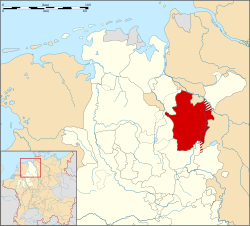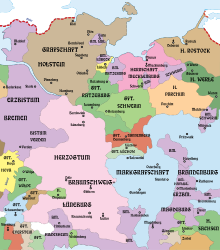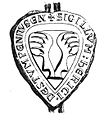County Hoya
|
Territory in the Holy Roman Empire |
|
|---|---|
| County Hoya | |
| coat of arms | |

|
|
| map | |

|
|
| County Hoya 1560 | |
| Alternative names | von (der) Hoyen |
| Form of rule | monarchy |
| Ruler / government | Count |
| Today's region / s | DE-NI |
| Parliament | Reichsfürstenrat , Secular Bank: Part of a 1 curiate vote of the Lower Rhine-Westphalian Count College |
| Reich register | 2 horsemen, 8 foot soldiers, 28 guilders (1522) |
| Reichskreis | Lower Rhine-Westphalian |
| Capitals / residences | Hoya , Nienburg |
| Dynasties | House Hoya, from 1582 Calenberg or Kurhannover |
| Denomination / Religions | Roman Catholic , Protestant from the 16th century |
| Language / n | German |
| surface | 1,400 km² (around 1800) |
| Residents | 60,000 (around 1800)
|
The county of Hoya was a territory of the Holy Roman Empire in the Lower Rhine-Westphalian Empire mainly west of the Central Weser . The former district of the same name and today's integrated municipality were named after her.
history
The origin of the Counts of Hoya is only legendary. The essence of this is that a nobleman of unknown name from Friesland - perhaps also of Frisian origin himself - was expelled from the area between Oldenburg and today's Wilhelmshaven and tried to build a new ancestral seat further south with rich booty, whereby he got into conflicts with the bishop of Verden and the Count of Wunstorf got. Ultimately, he was able to establish himself on a Weser island near an already existing place Hoya with his newly built Hoya Castle.
A document proves that Heinrich, son of the Frisian , was the first Count of Hoya in 1202 in the retinue of Archbishop Hartwig II of Bremen. In 1215, 1219 and 1220 he had the two bear paws of the gentlemen in his seals and since 1181 Count of Stumpenhausen with the inscription SIGILLVM HENRICI DE STVMPENHVS. His father, however, did not descend from the noblemen and counts of Stumpenhusen, attested from 1091 onwards, who had their castle near Wietzen . Rather, the brothers Count Stumpenhausen - Heinrich († 1205) and the Ultimus of the first house Stumpenhusen, Burchard († 1231) - in 1202 had sold goods, seals and coats of arms, probably also the name and title of count of the house, to Heinrich, who so made a Stumpenhausen and Count, which he then used for Hoya.
Around 1205 the Lords of Hodenberg , guardians of the Bücken Monastery, related to the first house of Stumpenhusen, were ousted by Heinrich, the first Count of Hoya. In 1215 the Free County of Nienburg was bought. That was the trigger for centuries of conflict with the diocese of Minden , which saw its territory threatened. Nevertheless, the Counts of Hoya expanded their territory further south via Liebenau , Steyerberg , Stolzenau , Uchte and Diepenau . In 1338 they bought the county of Altbruchhausen, which was followed a little later by the acquisition of the county of Neubruchhausen. At times, Thedinghausen , Wildeshausen and even the Loccum monastery also belonged to the county of Hoya . The greatest extent of the county ranged from Bremen in the north to the Minden monastery in the south, from the counties of Oldenburg and Diepholz in the west to the Weser in the east. It thus encompassed almost the entire Middle Weser region and an area of 2250 km² - about the size of today's Saarland.

In 1345 the county was divided between two count brothers into the upper county (Nienburg line) and the lower county (Hoyaer line). To distinguish them, the gentlemen of the Upper County called themselves "Graf von Hoya" and the Lord of the Lower County "Count of Hoya and Bruchhausen". The county was ruled together, and important decisions were made together. In 1497 the Hoya line died out and fell to Nienburg .
The Hoya Feud was a feud from 1351 to 1359 between the Hanseatic city of Bremen and the county of Hoya. Bremen, weakened by the plague , allowed more immigration from the surrounding area for several years and former serfs acquired their civil liberty after a year in Bremen. In 1356 the Count von Hoya claimed extradition for some of his own people who had moved - now free citizens - which Bremen refused to grant. It came to the feud between Bremen and Hoya, which was supported by the Duke of Jülich . Bremen lost in a battle on the Aller in 1358 and had to pay high trigger sums for its prisoners.
The county's decline began in the early 16th century. The Counts of Hoya were heavily in debt, mainly through their military ventures. Furthermore, they were harassed by their powerful neighbors, the Dukes of Braunschweig-Lüneburg . In 1512 the county was occupied by the Guelph dukes and the count family found refuge with their East Frisian relatives. In 1519 the counts were allowed to return and take possession of their county again. For this a large sum had to be paid and the county had to be taken as a fiefdom by the neighboring dukes.
As early as 1523, Count Jobst II. Von Hoya confessed to the teachings of Luther , who in 1525 sent the reformer Adrian Buxschott to Nienburg.
On February 25, 1582, the last Count of Hoya, Otto VIII. , Died at Hoya Castle , the family seat. The county of Hoya was divided among the Guelph lines. These were later also rulers of the county of Hoya as electors and kings of Hanover . In 1866 the county with Hanover fell to Prussia . The County of Hoya has been in Lower Saxony since 1946 .
From 1932 to 1977, the county of Hoya existed with its seat in Syke . The joint municipality of Hoya renamed itself in 1979 to " Samtgemeinde Grafschaft Hoya ", thus establishing a relationship with the former county. This name was retained after the merger with the Eystrup municipality in 2011.
Counts of Hoya
Reigns of the Counts of Hoya
|
|
|
|---|---|
| County Hoya (yellow area in red circle) around 1250 |
- Old line 1202-1345
- 1202–1235 Heinrich I.
- 1235–1290 Heinrich II.
- 1290–1313 Gerhard II.
- 1313–1324 Otto II.
- 1324-1345 Gerhard III. and Johann II.
- Hoyaer line 1345-1497 (Lower County)
- 1345–1383 Gerhard III.
- 1383-1428 Otto III.
- 1428–1451 Otto V.
- 1451–1497 Otto VII. And 1457–1503 Friedrich (jointly)
- Nienburg Line 1345–1582 (1345–1497 Upper County)
- 1345–1377 Johann II.
- 1377–1426 Erich I.
- 1426–1466 Johann V.
- 1466–1507 Jobst I.
- 1507–1545 Jobst II.
- 1545–1563 Albrecht II.
- 1547 ff. Johann VIII. (Stolzenau County)
- 1563–1575 Erich V.
- 1575–1582 Otto VIII.
On bishops' chairs
- 1251–1269 Gerhard I.
- 1407–1426 Heinrich II.
- 1253–1261 Wedekind I.
- 1397–1398 Gerhard III.
- 1436–1473 Albrecht von Hoya
- 1442–1463 Gerhard III.
- 1410–1424 Otto IV. Von Hoya as Otto II.
- 1437–1442 Erich II. Von Hoya as administrator Erich I.
- 1450–1454 Albrecht von Hoya
- 1553–1574 Johann VIII. Von Hoya as Johann IV.
- 1392–1424 Otto IV. Von Hoya (dynastic census) as Otto IV. (Bishop census )
- 1450-1457 Erich II. Von Hoya as counter-bishop Erich I.
- 1566–1575 Johann VIII. Von Hoya as Johann III.
- 1394–1399 Johann I , also as Johann III. Bishop of Hildesheim
- 1568–1574 Johann VIII. Von Hoya as administrator Johann II.
- 1398-1424 Johann III. , also as Johann I Bishop of Paderborn
Other personalities from the count's house
- Hadewig von Hoya , 1363–1365 Abbess in Bassum
- Katharina von Hoya , abbess in Wienhausen 1412–1474
- Mechthild von Hoya , 1452–1467 abbess in Wunstorf
- Margarethe von Hoya , 1541–1549 abbess in Bassum
- Anna von Hoya , 1549–1584 abbess in Bassum
- Johann VII von Hoya , governor of Vyborg since 1530 . Married to Margareta Wasa , Gustav Wasa's sister .
County Hoya
The following castles, fortresses and monasteries essentially belonged to County Hoya. The palaces and fortresses also served as the administrative seat of an office.
Palaces and castles
- Altbruchhausen
- Barenburg
- Diepenau
- Drakenburg (no office)
- Ehrenburg
- Freudenberg
- Harpstedt
- Hoya
- Liebenau
- Neubruchhausen (no office)
- Nienburg Castle with stock tower
- Siedenburg
- Steyerberg
- Stolzenau Castle
- Syke
- Thedinghausen
- Uchte
Monasteries
- Pen bending over
- Bassum Abbey
- Schinna Monastery
- Nendorf Monastery
- Heiligenberg Monastery
- Heiligenrode Monastery
Coins
Historical evidence of their work are the coins that the Counts of Hoya left us. Your country was too small to have its own currency. They have therefore imitated coins from neighboring coin stands.
First, from around 1230 onwards, the counts had hollow pfennigs minted, which are similar to those of the city of Hamburg and the margraviate of Brandenburg . Only the coat of arms of the bear paws added to the coin design distinguishes them from their models. After a break that follow from the beginning of the 1370s Sware who in the simultaneous coins of the bishops of Münster their model. Later the goods of the city of Bremen were copied. At the end of the minting activity of the Counts of Hoya, there are imitations of coins minted by a Wendish mint association . It is that of the Hohlpfennig , Blaffert and the Witte , which circulated in the county as foreign money.

coat of arms
The coat of arms of the Counts of Hoya shows two upright black bear paws with long claws turned outward . The noblemen, and since 1181 counts, von Stumpenhusen kept these bear paws on their shields until 1202. After the county fell to the Guelph, they introduced the bear claws as a crest on its coat of arms. This is the case with Duke Georg Wilhelm (1648–1705), which can still be seen in some places in the royal seat of Celle.
Today the bear paws can be found in the coats of arms of many municipalities in the area of the former County of Hoya, often just one bear paw. These are u. a. the districts of Nienburg (Weser) and Diepholz , the cities of Nienburg / Weser , Hoya , Syke , Bassum and Sulingen , the joint municipalities of Siedenburg , Bruchhausen-Vilsen , Eystrup , Kirchdorf , Uchte , Heemsen , Marklohe and in the municipalities of Maasen , Mellinghausen , Staffhorst , Steyerberg , Stolzenau , Bücken and Wietzen . Furthermore, many organizations and clubs use the bear paws as a logo.
Coat of arms of County Hoya
Coat of arms of the Nienburg district
Coat of arms city of Nienburg
Coat of arms city of Hoya
Coat of arms municipality of Bücken
Coat of arms city of Syke
The “Nienburger Bärentatzen ”, a biscuit or fine baked product created by the local Facompré family, are well known. They are available in many bakeries in the area.
There is also the “Nienburger Bear Trail”: 500 bear paws on the pavement of the old town show tourists the way to the sights, comparable to the red thread in the state capital.
literature
- Gernot Erler : The late medieval territory of County Hoya (1202–1582). University (Philosophical Faculty), Göttingen 1972 (dissertation).
- H. Gade : Historical-geographical-statistical description of the counties Hoya and Diepholz. 2 volumes. Schaper, Hanover 1901 (reprint. Lesberg, Nienburg 1980–1981, ISBN 3-920244-08-7 (Vol. 1), ISBN 3-920244-09-5 (Vol. 2)).
- Klaus Giesen: The coins of the Counts of Hoya. Money and coin history, coin finds, mint catalog. Numismatischer Verlag Künker, Osnabrück 2004, ISBN 3-9801644-6-2 .
- Wilhelm von Hodenberg (Ed.): Hoyer document book. 8 volumes a. Register tape. Jaenecke, Hanover 1848–1856.
- Gustav Adelbert Seyler , Siebmacher's large and general book of arms, Volume I, Section 1, Part 2; Coat of arms of the German sovereigns and countries; Nuremberg, 1909, pp. 115–117, plate 118
- Bernd Ulrich Hucker : The Counts of Hoya. their history in pictures of life (= writings of the Institute for History and Historical Research, Vechta 2). Publishing house for regional history, Bielefeld 1993, ISBN 3-927085-84-7 .
- Cord Meyer: He thinks of the hoye Gerhart and the poet Frauenlob: courtly culture around the Counts of Hoya . University of Oldenburg, Oldenburg 2002, ISBN 3-8142-0839-0 ( uni-oldenburg.de [PDF; accessed on September 8, 2017]).
- Museum Nienburg (ed.): The counties Bruchhausen, Diepholz, Hoya and Wölpe. A journey through history. (= Writings of the Museum Nienburg, Weser 18). Museum association for the counties of Hoya, Diepholz and Wölpe, Nienburg 2000, ISBN 3-9802844-7-6 .
- Dieter Riemer : Counts and gentlemen in the ore monastery of Bremen as reflected in the history of Lehes. Mauke, Hamburg 1995, ISBN 3-923725-89-2 , pp. 131-137 (also: Oldenburg, Univ., Diss.).
Web links
Individual evidence
- ↑ a b Gerhard Köbler : Historical Lexicon of the German Lands. The German territories and imperial immediate families from the Middle Ages to the present. 5th, completely revised edition, Verlag C. H. Beck, Munich 1995, ISBN 3-406-39858-8 , pp. 277-278.
- ↑ Press article on the merger

















